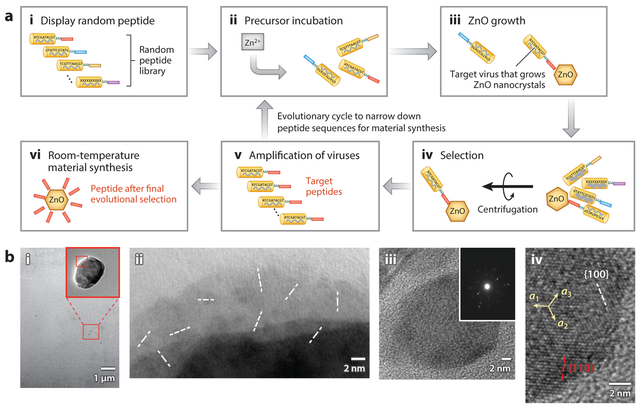Figure 2.
Combinatorial phage-display approach to the identification of peptides that crystallize zinc oxide (ZnO) at room temperature.(a) Screening of a phage-display peptide library. (i,ii) The phage-displayed library and the zinc precursor (10 mg/mL zinc nitrate solution) were coincubated for 3 days at room temperature. (iii) Some of the peptides on the phage template accelerated the growth of ZnO nanocrystals. (iv) The phage–ZnO complexes were retrieved from the library by centrifugation. (v) After washing to remove nonspecific phages, the residual phage viruses were released from the ZnO anchor with an acid treatment and amplified. (vi) The selected peptide ZP-1 can catalyze ZnO nanocrystal growth without a phage template by incubating the same zinc nitrate precursor and pure peptide. (b) Microscopy studies of ZnO mineralization process promoted by ZP-1 peptide. (i) Transmission electron microscopy (TEM) image of ZnO nanoparticles after 4 days’ incubation in the precursor solution. (Inset) Magnified image of the area within the red square. (ii) High-resolution TEM (HRTEM) image of the square region in panel i, showing nanoparticle domains with (100) faces (white dashed lines) oriented in random directions. (iii) TEM image of ZnO nanocrystals after 3 weeks’ incubation in the precursor solution with the peptide. (Inset) Nanobeam electron diffraction pattern of this nanocrystal showing single crystallinity, with a [0001] transmission direction. (iv) HRTEM image of panel iii, resolving (100) faces (white dashed lines) and (110) faces (red dashed lines). Faces are indicated by arrows.

